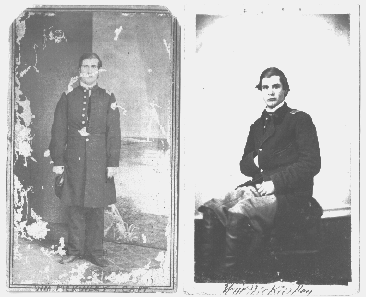 . . .had I not known what it was, I would have assumed just by looking at it that it was a product of the 1960s, not the 1890s. But inside the covers of this far-out notebook were the signatures of 87 men who served in the 48th Pennsylvania and the minutes of a reunion held by the survivors of Companies A & C in Port Clinton, Pennsylvania. This notebook was used twice during the 1890s for reunions; first on August 29, 1891--29 years to the day of the regiment's baptism by fire at 2nd Bull Run--and on October 11, 1895. It was, essentially, a register. Upon arriving at each of these two reunions, the aging veterans signed their names, along with their current address or place of residence. In the back of the book, are six pages listing the names of soldiers from the two companies who were killed or died during the war, and lists of those who passed away in the years between 1865 and 1891. The secretary of these two reunions was John Shenk, who served in Company A, 48th PA, and I can only assume that this book belonged to him and his family since in the back I found clipped obituaries of John's widow following her death in 1916, plus notices of the death of Henry Shenk, John & Malinda's son.
. . .had I not known what it was, I would have assumed just by looking at it that it was a product of the 1960s, not the 1890s. But inside the covers of this far-out notebook were the signatures of 87 men who served in the 48th Pennsylvania and the minutes of a reunion held by the survivors of Companies A & C in Port Clinton, Pennsylvania. This notebook was used twice during the 1890s for reunions; first on August 29, 1891--29 years to the day of the regiment's baptism by fire at 2nd Bull Run--and on October 11, 1895. It was, essentially, a register. Upon arriving at each of these two reunions, the aging veterans signed their names, along with their current address or place of residence. In the back of the book, are six pages listing the names of soldiers from the two companies who were killed or died during the war, and lists of those who passed away in the years between 1865 and 1891. The secretary of these two reunions was John Shenk, who served in Company A, 48th PA, and I can only assume that this book belonged to him and his family since in the back I found clipped obituaries of John's widow following her death in 1916, plus notices of the death of Henry Shenk, John & Malinda's son. Having no new pictures of Nicodemus Heights this week, I thought I would share the contents of this really cool 48th PA Survivors's Reunion record book. . .


.JPG)

Resolutions passed at the August 29, 1891 reunion. . . .
At a meeting held this 29th day of August 1891, the following Preamble and resolutions were passed.
Whereas we have once more had the privilege to meet in reunion as comrades and soldiers who stood shoulder to shoulder during the dark days of the Rebelion of 1861 to 1865, and who through the mercy of our great commander-in-chief still have the privilege of enjoying the blessings of a free and undivided country and to grasp each other by the hand in that fraternal spirit which only exists among those who have passed through the trying ordeal of a soldiers life, And--
Whereas the privilege is granted us to gather at the place where over a quarter of a century ago we left our homes and dear ones, And since the Citizens of Port Clinton in their untiring efforts to make our visit and stay among them a pleasant one have given us such a grand reception which will be looked back to by every member of the organizations here represented as one of the pleasantest days of their lives, therefore be it
Resolved--that a unaminous vote of thanks be tendered the Citizens committee for their kind reception and generous treatment during our stay among them and to the P.O.S. of A. [Patriotic Order Sons of America] for the use of their Hall and to all who by their efforts made this a day of pleasure to us all.
As there was no other means employed to make up the necessary expenses of this days exercises except to selling of badges the expenses exceeded the income by Four Dollars which amount was advanced by Comrades Jno. Shenk and J.W. Sterner the organization therefore stands indebted to the above named comrades for said amount. The following named officers were elected to serve during the ensuing term: Capt. A.C. Huckey, President. John Shenk Secretary and James W. Sterner Treasurer. The following named committee was also elected for the ensuing therm Daniel Leiser New Ringgold, Monroe Heckman, Shoemakersville, Charles W. Hillegas, Tamaqua, William J. Huckey, Pottsville, Henry L. Weikel, Mauch Chunk and John A. Holman, Morea. There being no other business the meeting therefore adjourns to meet again at the call of the officers of the association.
John Shenk, Secretary
I love it. Shenk made sure everyone knew that he and Sterner put up the four bucks to meet expenses. . . .




.JPG)











 Sergeant William McKinley, Commissary, 23rd Ohio Volunteers
Sergeant William McKinley, Commissary, 23rd Ohio Volunteers













 Jeb Stuart
Jeb Stuart Edward Cross
Edward Cross Ambrose Powell Hill
Ambrose Powell Hill James Longstreet
James Longstreet




